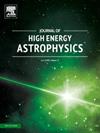The interplay of WGC and WCCC via charged scalar field fluxes in the RPST framework
IF 10.5
4区 物理与天体物理
Q1 ASTRONOMY & ASTROPHYSICS
引用次数: 0
Abstract
In this paper, we investigate the weak cosmic censorship conjecture (WCCC) for the Reissner-Nordström (R-N) AdS black hole within the framework of restricted phase space thermodynamics (RPST). Additionally, we consider energy flux and the equivalence mass-energy principle to examine the weak gravity conjecture (WGC) alongside the weak cosmic censorship conjecture. The interaction of incoming and outgoing energy flux leads to changes in the black hole. We examine whether the second law of thermodynamics holds in this scenario. It is noted that, when absorption and superradiance reach equilibrium, and by using the thermodynamics of black holes in restricted phase space, if the black hole is in or near an extreme state with radiation and particle absorption, the weak cosmic censorship conjecture is upheld. Furthermore, by employing the equivalence mass-energy principle and second-order approximation near extremality, we find that when the black hole radiates and its central charge exceeds the scaled electric charge, the superradiance particles adhere to the weak gravity conjecture. This causes the black hole to move away from its extreme state. However, when particles that obey the weak gravity conjecture are attracted to a very small black hole, the black hole approaches its extremality state.
在RPST框架下,带电标量场通量对WGC和WCCC的相互作用
本文在受限相空间热力学(RPST)的框架下,研究了Reissner-Nordström (R-N) AdS黑洞的弱宇宙审查猜想(WCCC)。此外,我们考虑了能量通量和等效质能原理来检验弱引力猜想(WGC)以及弱宇宙审查猜想。流入和流出的能量流的相互作用导致了黑洞的变化。我们检验热力学第二定律在这种情况下是否成立。注意到,当吸收和超辐射达到平衡时,利用有限相空间中黑洞的热力学,如果黑洞处于或接近具有辐射和粒子吸收的极端状态,则支持弱宇宙审查猜想。此外,利用等效质能原理和二阶逼近极值,我们发现当黑洞辐射且其中心电荷超过标度电荷时,超辐射粒子符合弱引力猜想。这使得黑洞远离它的极端状态。然而,当服从弱引力猜想的粒子被吸引到一个非常小的黑洞时,黑洞就会接近它的极限状态。
本文章由计算机程序翻译,如有差异,请以英文原文为准。
求助全文
约1分钟内获得全文
求助全文
来源期刊

Journal of High Energy Astrophysics
Earth and Planetary Sciences-Space and Planetary Science
CiteScore
9.70
自引率
5.30%
发文量
38
审稿时长
65 days
期刊介绍:
The journal welcomes manuscripts on theoretical models, simulations, and observations of highly energetic astrophysical objects both in our Galaxy and beyond. Among those, black holes at all scales, neutron stars, pulsars and their nebula, binaries, novae and supernovae, their remnants, active galaxies, and clusters are just a few examples. The journal will consider research across the whole electromagnetic spectrum, as well as research using various messengers, such as gravitational waves or neutrinos. Effects of high-energy phenomena on cosmology and star-formation, results from dedicated surveys expanding the knowledge of extreme environments, and astrophysical implications of dark matter are also welcomed topics.
 求助内容:
求助内容: 应助结果提醒方式:
应助结果提醒方式:


